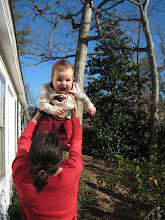
What it is, when baby can eat it, how to find it & how to make it…
Malanga is a root vegetable. It’s very easy to digest and is extremely hypoallergenic , so it’s an excellent food to introduce to babies’ developing digestive systems. It’s so gentle that I can eat it when my tummy is feeling a little off and it satisfies my hunger better than Saltines and plain broth do. The taste is hard to describe, but it’s much more flavorful than potatoes or yuca (cassava).
My love for the malanga is a given at this point, but when I started feeding my daughter solid foods, I had no idea when I could introduce it to her. Web sites like
wholesomebabyfood.com, while full of charts and recipes and detailed information on appropriate age ranges for a just about every other vegetable, didn’t say a word about malanga. (Although I was happy to find passion fruit under the “exotic foods” section of that web site.) Conversations with my mom and other relatives didn’t help. To hear them tell it, my cousins and I we were all walking, talking, sleeping through the night and eating a full range of fruits and vegetables by six months of age.
So here’s my best guess based on what I’ve read about other baby food in general and the malanga in particular: my daughter is ready for it now, at seven months, three weeks old. I wouldn’t introduce it as a first food at six months because I just couldn’t get any confirmation that it’s ok to start with a starch that early. Potatoes, for example, are only recommended for babies ages 8 months and up. However, the fact that malanga has such low allergy potential and has much higher nutritional content than a potato made me give it the bump to “ok to introduce just before 8 months of age.” That's just me. If you happen to have a Cuban or Puerto Rican pediatrician, ask him/her.
So now let’s get to the technicalities: how to shop for malanga and how to prepare it.
SHOPPING: In New York, I tried Whole Foods because I am somewhat obsessed with Whole Foods and fantasized about an organic malanga. To my knowledge, there's no such thing. The folks at WF had no idea what I was talking about, although they did steer me over to some yuca (not organic). Best bet: any of the grocery stores in my primarily Latin neighborhood of Jackson Heights. If you're serious about coming out here to buy one, I would say that the Trade Fair has a much better selection than the Met. In fact, the selection was so vast that I had to make a quick call to my papi to find out whether I wanted a white malanga or a yellow one. The answer is white. The color refers to the inside. On the outside, it should look long and hairy, like the picture above.
The malanga should be hard. Watch out for any soft spots or moldy growth.
Note that it is also called YAUTIA. Malanga and yautia are one and the same thing. One long malanga should yield you a good amount to try with baby. Two is good if you know you like it and want to make puree for the whole family. Three is excessive. Last night, I bought three.
PREPARATION: Wash your less-than-attractive little malangas at home and get ready to peel them right in the sink. Those hairy skins reveal a very slippery surface underneath and you don't want them flying out of your hands and bouncing all over your kitchen. Set some water to boil on the stove while you do this.
Next, cut the malanga into equal-sized, thick rounds. It tends to start falling apart in the boiling water if you cut it too thin or in small cubes. Drop these into a pot of boling water and check it after 10 or 15 minutes. Be sure to inhale the delicious smell they release as they boil. The malanga should have gotten good and soft by fifteen minutes, but if not, my aunt Silvia says to turn off the heat and just leave them in the pot with the hot water until they get softer.
Remove the malanga with a slotted spoon and proceed to mash or puree. The malanga will mash quite easily (if not, see above, it will need to cook more), but I put it in the food processor with some of the cooking water for my daughter to make an extra smooth puree. For older children and adults, no food processing is necessary. Just mash away with a fork.
For babies: You can add some breast milk or formula to the puree.
For adults: Add salt & pepper if you like.
RESULT: Malanga Baby & I had a delicious meal last night. She seemed to enjoy her first taste of malanga and I made enough to have a plate full myself with leftovers. I don't yet know how well the malanga freezes in the baby cubes, but I'll report back when the time comes to remove them from the freezer.






